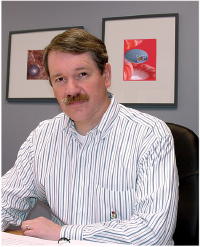
Senior Research Fellow, Institute for Molecular Manufacturing
|
E-mail address: Personal Home Page: |
rfreitas
at rfreitas dot com http://www.rfreitas.com |
|
Robert A. Freitas Jr. |
 |
Senior Research Fellow, Institute for Molecular Manufacturing
|
Robert A. Freitas Jr., J.D., published the first detailed technical design study of a medical nanorobot ever published in a peer-reviewed mainstream biomedical journal and is the author of Nanomedicine, the first book-length technical discussion of the medical applications of nanotechnology and medical nanorobotics. Volume I was published in October 1999 by Landes Bioscience while Freitas was a Research Fellow at the Institute for Molecular Manufacturing (IMM) in Palo Alto, California. Freitas published Volume IIA in October 2003 with Landes Bioscience while serving as a Research Scientist at Zyvex Corp., a nanotechnology company headquartered in Richardson, Texas during 2000-2004. Freitas is now completing Nanomedicine Volumes IIB and III and is also consulting on diamond mechanosynthesis, molecular assembler design, and nanofactory implementation as Senior Research Fellow at IMM. He won the 2009 Feynman Prize in nanotechnology for theory, the 2007 Foresight Prize in Communication, the 2006 Guardian Award from Lifeboat Foundation, the 2005 Harold Ellis Award from the International Journal of Surgery, and was awarded the first patent on diamond mechanosynthesis on 30 March 2010.
| 50-word Bio | 100-word Bio | 150-word Bio | Experience/Education (CV) |
| 250-word Bio | 250-word Journal Bio | WTN Bio | Bio (Russian language) |
| Interview (September 1999) | Pr. Release (March 2000) | Interview (August 2000) | Interview (September 2000) |
| Interview (July 2004) | Olson Interview - Pt. 1 (6 October 2005) | Olson Interview - Pt. 2 (6 October 2005) | Technology Review interview (German language, April 2006) |
| Lifeboat Interview (April 2007) | Ray Kurzweil interviews Robert Freitas (30 May 2007) | Google Scholar citations | Current Bio |
| Alcor Q&A (2008) p. 9 | Harvey Mudd College bio (2017) | Wikipedia Page | Alcor Scholar Profile (2022) |
“Robert Freitas has pioneered the study and communication of the benefits to be obtained from an advanced nanomedicine that will be made possible by molecular manufacturing. He has also worked to develop and communicate a path from our current technology base to a future technology base that will enable advanced nanomedicine.”
-- Dr. Pearl Chin, President, Foresight Institute, upon awarding the 2007 Foresight Prize in Communication to Freitas on 9 October 2007
“The winner of the 2009 Feynman Prize for Theory is Robert A. Freitas Jr., in recognition of his pioneering theoretical work in mechanosynthesis in which he proposed specific molecular tools and analyzed them using ab initio quantum chemistry to validate their ability to build complex molecular structures. This Prize also recognizes his previous work in systems design of molecular machines, including replicating molecular manufacturing systems which should eventually be able to make large atomically precise products economically and the design of medical nanodevices which should eventually revolutionize medicine.”
-- Foresight Institute press release, announcing award of the 2009 Feynman Prize in nanotechnology for theory to Freitas on 6 October 2009
“The term nanomedicine emerged in 1999, the year when American scientist Robert A. Freitas Jr. published Nanomedicine: Basic Capabilities, the first of two volumes he dedicated to the subject. Extending American scientist K. Eric Drexler’s vision of molecular assemblers with respect to nanotechnology, nanomedicine was depicted as facilitating the creation of nanobot devices (nanoscale-sized automatons) that would navigate the human body searching for and clearing disease....”
-- “Nanomedicine,”Encyclopedia Britannica, 2 August 2016
“The term 'nanomedicine' was put forward by Eric Drexler and Robert Freitas Jr. in the 1990s to signify the application of nanotechnology in medicine.”
-- Sun M, Sen Gupta A. Vascular Nanomedicine: Current Status, Opportunities, and Challenges. Semin Thromb Hemost. 2019 Jun 14.
Nanomedicine. The most important applications of machine-phase nanotechnology will be in medicine. Not only will human health, comfort, safety, and pleasure be vastly improved, but nanomedicine could dramatically extend the lifespan of the individual human being and greatly expand the possibilities of the human form. In 1996, I authored the first detailed technical design study of a medical nanorobot ever published in a peer-reviewed mainstream biomedical journal. Now I’m trying to help lay the technical foundations for the future field of medical nanorobotics by conducting theoretical analyses of specific nanomedical systems and by writing a 4-volume technical book series entitled Nanomedicine. This book series looks at all relevant issues including basic engineering capabilities, biocompatibility, systems and operations of medical nanorobots, clinical applications, and ethical issues. The first two volumes – I (1999) and IIA (2003) – are now published. The remaining two volumes of Nanomedicine are in progress, and a compilation of medical nanorobot technical designs can be found at my nanomedicine.com website. Please also visit my Nanomedicine Page – the first active site on the web for nanomedicine-related information, research, and links, including medical nanorobotics – which was hosted for me by the Foresight Institute until 2021. The Nanomedicine Page includes a nontechnical nanomedicine FAQ and hundreds of links to articles, papers, websites, people and organizations who are active in the field of nanomedicine. In 2010, I published a comprehensive summary of the application of medical nanorobotics to health care and anti-aging (extreme longevity).
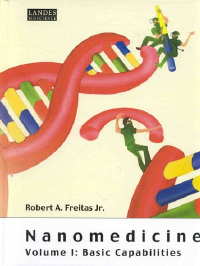 |
Nanomedicine, Vol. I: Basic Capabilities (Landes Bioscience, 1999). The first volume of the Nanomedicine book series describes the set of basic capabilities of molecular machine systems that may be required by many, if not most, medical nanorobotic devices, including the physical, chemical, thermodynamic, mechanical, and biological limits of such devices. Specific topics include the abilities to recognize, sort and transport important molecules; sense the environment; alter shape or surface texture; generate onboard energy to power effective robotic functions; communicate with doctors, patients, and other nanorobots; navigate throughout the human body; manipulate microscopic objects and move about inside a human body; and timekeep, perform computations, disable living cells and viruses, and operate at various pressures and temperatures. Read Text free online ..... Purchase Hardcover online ..... Purchase Softcover online ..... Purchase Softcover online ..... Purchase directly from Landes Bioscience ..... Chapter 3 (early version, Foresight Institute) ..... Japanese Language Version (Cover Only, HTML) Review by Gregory M Fahy, Ph.D. and here; Review by Lawrence Rosenberg, M.D., Ph.D.; see all Reviews. See note regarding left-handed DNA depicted in cover art. |
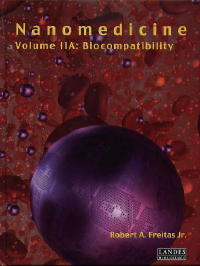 |
Nanomedicine,
Vol. IIA: Biocompatibility (Landes
Bioscience, 2003).
The safety, effectiveness, and utility of medical nanorobotic devices
will critically depend upon their biocompatibility with human organs,
tissues, cells, and biochemical systems. In this second Volume of the
Nanomedicine technical book series, we broaden the definition of nanomedical
biocompatibility to include all of the mechanical, physiological, immunological,
cytological, and biochemical responses of the human body to the introduction
of artificial medical nanodevices, whether “particulate” (large
doses of independent micron-sized individual nanorobots) or “bulk”
(nanorobotic organs assembled either as solid objects or built up from
trillions of smaller artificial cells or docked nanorobots inside the
body) in form.
Read Text free online ..... Purchase Hardcover online ..... Advance Purchase directly from Landes Bioscience ..... Subscription Version online at eurekah.com (PDF) See all Reviews |
lowres.jpg) |
Nanomedicine,
Vol. IIB: Systems and Operations (in preparation). This Volume
will consider systems-level technical requirements in the design and operation
of medical nanodevices, including: scaling factors and general design
principles; control issues including teleoperation and haptic controllers,
swarm motions, autogenous control systems, and various operational protocols;
repair, replacement, and reliability; molecular machine system architectures
and deployment configurations such as nano-organs, medical utility fogs,
and replicators; methods of nanorobotic ingress and egress from the human
body; possible nanodevice failure modes, environmental interactions, side
effects of nanomedical treatments, nanodevice software bugs and other
safety issues; classes of medical nanosystems such as instruments, tools,
and diagnostic systems; specific medical nanorobot devices; rapid mechanical
reading and editing of chromatin and protein macromolecules; and complex
nanorobotic systems for cell repair, tissue and organ manufacturing, and
personal defense.
|
lowres.jpg) |
Nanomedicine,
Vol. III: Applications (in preparation). This Volume will
consider the full range of nanomedical applications which employ molecular
nanotechnology inside the human body, from the perspective of a future
practitioner in an era of widely available nanomedicine, including: rapid
cardiovascular repair; treatments for pathogenic disease and cancer; responses
to physical traumas, burns and radiation exposures, with new methods of
first aid, surgery, and emergency or critical care; neurography, spinal
restoration and brain repair; improved nutrition and digestion; sex, reproduction,
and population issues; cosmetics, recreation, veterinary and space medicine;
strategies for biostasis and the control of aging processes; human augmentation
systems; regulatory and sociological issues, implementation timelines,
and the future of hospitals, pharmaceutical companies, and the medical
profession.
|
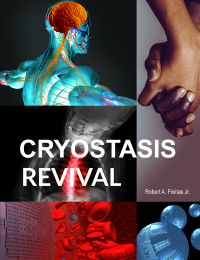 |
Cryostasis
Revival (Alcor Life Extension Foundation, 2022). Cryostasis
is an emergency medical procedure in which a human patient is placed in
biological stasis at cryogenic temperatures. A cryopreserved patient can
be maintained in this condition indefinitely without suffering additional
degradation, but cannot yet be revived using currently available technology.
This book presents the first comprehensive conceptual protocol for revival
from human cryopreservation, using medical nanorobots. The revival methods
presented in this book involve three stages: (1) collecting information
from preserved structure, (2) computing how to fix damaged structure,
and (3) implementing the repair procedure using nanorobots manufactured
in a nanofactory – a system for atomically precise manufacturing
that is now becoming visible on the technological horizon.
|
Molecular Assemblers and Nanofactories. Molecular nanotechnology involves the ability to build structures that are permitted by physical laws, to molecular precision. I am primarily interested in positional assembly, which is a deterministic process in which the components used in a construction are held in known positions and are constrained to follow desired intermediate physical pathways during the entire construction sequence. This is the future technology that may enable us to build medical nanorobots. Programmable positional assembly at the molecular scale is the central mechanism for achieving both great flexibility and the ultimate in precision and quality in manufacturing. A proposal for the next logical R&D step is here, and a technical bibliography for research on positional mechanosynthesis is available here. The other key to practical molecular manufacturing is the ability to fabricate massive quantities of molecularly precise structures, or to assemble larger objects from vast numbers of molecularly precise smaller objects – that is, massively parallel assembly. The end result of this development process will be a basic molecular assembler that employs machine-phase nanotechnology (e.g., nanoscale gears, struts, springs, motors, casings) to fabricate molecularly precise diamondoid structures, following a set of instructions to build a desired specific design. With Ralph Merkle, I’ve undertaken theoretical analyses of possible molecular assembler systems. I’m co-authoring at least three technical books describing the results of this research. The first book, Kinematic Self-Replicating Machines, was published in October 2004 and was available at a substantial prepublication discount directly from Landes Bioscience. The second volume, Diamond Surfaces and Diamond Mechanosynthesis, is in progress and should be published in 2009-10. The third volume, Fundamentals of Nanomechanical Engineering originally to be co-authored with J. Storrs Hall, is still in preparation and might be published in 2009-10. Our international research collaborations, ultimately leading toward the development of a working nanofactory, are described at the Nanofactory Collaboration website.
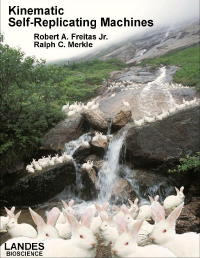 |
Kinematic Self-Replicating Machines (Landes Bioscience, 2004). This book offers a general review of the voluminous theoretical and experimental literature pertaining to physical self-replicating systems and self-replication. The principal focus here is on self-replicating machine systems. Most importantly, we are concerned with kinematic self-replicating machines: systems in which actual physical objects, not mere patterns of information, undertake their own replication. Following a brief burst of activity in the 1950s and 1980s, the field of kinematic replicating systems design received new interest in the 1990s with the emerging recognition of the feasibility of molecular nanotechnology. The field has experienced a renaissance of research activity since 1999 as researchers have come to recognize that replicating systems are simple enough to permit experimental laboratory demonstrations of working devices. Read Text free online ..... Purchase Hardcover online ..... Purchase Hardcover online ..... Advance Discount Purchase directly from Landes Bioscience ..... German Translation of Chapter 1 (HTML) See all Reviews |
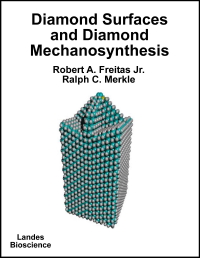 |
Diamond Surfaces and Diamond Mechanosynthesis (in preparation). A full analysis of how to use programmable positional assembly to synthesize most arrangements of atoms permitted by physical law would be, at present, prohibitively complex. A more manageable project is to analyze a significant class of stiff hydrocarbons – in particular, diamond – that could potentially be synthesized by the use of a small set of positionally controlled mechanosynthetic tool tips. There is already widespread interest in the exceptional properties of diamond such as extreme hardness, high strength and stiffness, high thermal conductivity, low frictional coefficient, chemical inertness, and a wide bandgap. The molecular surface characteristics of diamond were extensively investigated both theoretically and experimentally in the 1990s, and many practical questions about the molecular structure of diamond surfaces have now been resolved. The fields of diamond CVD and adamantane chemistry provide additional understanding, both experimental and theoretical, of the myriad reaction mechanisms which can contribute to the growth of diamond. A technical bibliography for research on positional mechanosynthesis is available here. The first patent ever issued on positional diamond mechanosynthesis is available here, and the second filed patent covers material described in this paper. See also the Nanofactory Collaboration website for the larger context of this research. |
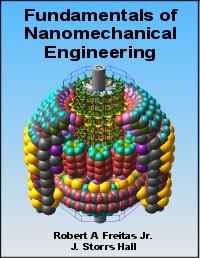 |
Fundamentals of Nanomechanical Engineering (in preparation). This course textbook, intended for use by 2nd or 3rd year college students in advanced engineering programs, will provide a solid grounding in the practical design of molecular scale machines composed of rigid covalent solids, with a strong emphasis on diamond and diamondoid materials. After an introduction to the unique aspects of nanoscale machinery and a review of the computational tools currently available to assist such designs, the mechanical characteristics of key materials and the fundamentals of load, stress, stiffness, and mechanical failure in nanoscale machinery will be explored in detail. This will be followed by discussions and examples of specific nanomechanical components and compound machines including bearings, fasteners, gears, linkages, drive mechanisms, motors and pumps, mechanical energy controllers, sensors, and programmable materials. |
Machine Self-Replication. A self-replicating machine system achieves massively parallel assembly first by fabricating copies of itself, and allowing those copies to fabricate further copies, resulting in a rapid increase in the total number of systems. Once the population of replicated manipulator systems is deemed large enough, the manipulator population is redirected to produce useful product objects, rather than more copies of itself. Following John von Neumann’s pioneering theoretical studies of kinematic replicating systems in the 1940s and 1950s, I served as NASA/ASEE Research Fellow and Study Editor for the 1980 NASA-sponsored study entitled Advanced Automation for Space Missions (NASA CP-2255), the first technical engineering study of kinematic self-replicating machines ever published. Recently I’ve co-authored a book-length survey (due to be published in 2003) of kinematic self-replicating machine systems, including both theoretical and experimental work in this reawakening field. My interest is focused on the context of molecular assembler design.
Advanced Automation for Space Missions (NTIS, 1982). This is the Final Report of the 1980 NASA/ASEE sponsored study of self-replicating lunar factories. It was the first technical engineering study of kinematic self-replicating machines ever published, and introduced new concepts such as qualitative and quantitative closure (and “vitamin parts”) in self-replicating machine systems design. |
Xenology and SETI (Search for Extra-Terrestrial Intelligence). In the 1970s I wrote a semi-technical book on this subject, entitled Xenology (~500,000 words, ~150 illustrations, 4000+ references). The material in this book, initially published only partially as a handful of articles but now entirely available online, was privately circulated and collected critical comments from such notables as Edward O. Wilson, Stanley L. Miller, Sidney W. Fox, Cyril Ponnamperuma, Stephen H. Dole, J. Desmond Clark, Barney M. Oliver, Frank D. Drake, Ronald Bracewell, and Robert L. Forward.
lowres.jpg) |
Xenology: An Introduction to the Scientific Study of Extraterrestrial Life, Intelligence, and Civilization (copyright 1979). Topics include the history of the idea of extraterrestrial life; comparative planetology, stars, and galaxies; xenobiology (definition/origin of life, exotic biochemistries, and possible alien bioenergetics, biomechanics, sensations, reproduction, and intelligence); extraterrestrial civilizations (energy sources, biotechnology, interstellar travel, alien weapons, planetary and stellar engineering, xenosociology, and extraterrestrial governments and culture); interstellar communication techniques; and the sociology, legal issues, and appropriate interaction protocols pertaining to first contact. Read Text free online ..... Tony Lutz version (all chapters) (whole book download) ..... AI-curated version of the book |
Other interests include: (1) quantitative cliodynamics (aka. “psychohistory”), including econometrics and financial forecasting; (2) structures and models of universal ethical systems; and (3) J.R.R. Tolkien studies.
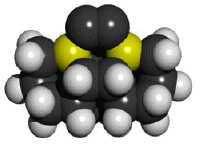 |
Diamond Mechanosynthesis
Tooltips (2002-10). Computational design study of a
new class of carbon dimer placement tool tips that might be useful for
performing positionally-controlled diamond mechanosynthesis (DMS). First
complete DMS tooltip ever proposed; also, first DMS tooltip computationally
demonstrated to work on a diamond surface.
Ralph C. Merkle, Robert A. Freitas Jr., “Theoretical analysis of a carbon-carbon dimer placement tool for diamond mechanosynthesis,” J. Nanosci. Nanotechnol. 3(August 2003):319-324; prev. paper presented at the 10th Foresight Conference on Molecular Nanotechnology, October 2002. Conference Abstract (HTML) ..... Full Paper (PDF) ..... Full Paper (HTML) ..... Full Paper (PDF) ..... Subsequent 2004 Paper I (PDF, 3 MB) ..... 2004 Paper II (PDF, 2 MB) ..... 2004 DMS lecture (HTML, 1.7 MB) ..... 2004 Patent Application (HTML, 0.93 MB) ..... 2006 Paper III (PDF, 1 MB) ..... 2008 Minimal Toolset paper (PDF, 6.5 MB) ..... First patent on DMS, issued 30 March 2010 (PDF, 1.2 MB) |
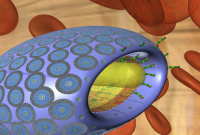 |
Microbivores
(2001, 2005). Detailed scaling study of a nanorobot-based
artificial white cell (a mechanical phagocyte).
Robert A. Freitas Jr., “Microbivores: Artificial Mechanical Phagocytes using Digest and Discharge Protocol,” J. Evol. Technol. 14(April 2005):1-52; orig. Zyvex preprint, March 2001. Full Paper (HTML) ..... Full Paper (PDF) ..... Full Paper (early version, HTML) ..... Summary Article (HTML) ..... Summary Article (HTML) ..... Russian Translation Summary Article (HTML) ..... Nanomedicine Art Gallery images |
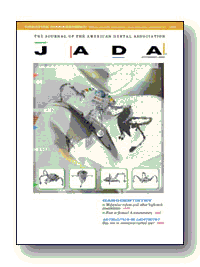 |
Nanodentistry (2000). First front cover of a peer-reviewed mainstream medical journal (Journal of the American Dental Association) for a paper on medical nanorobotics. Robert A. Freitas Jr., “Nanodentistry,” J. Amer. Dent. Assoc. 131(November 2000):1559-1566. (cover story) PubMed Abstract (HTML) ..... Full Paper (PDF, 0.3 MB) ..... Excerpt from Paper (HTML) ..... Nanomedicine Art Gallery images
|
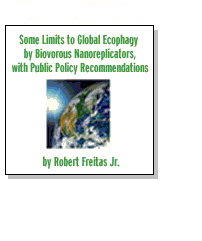 |
Ecophagy (2000). The best defense against the deliberate abuse of molecular nanotechnology is preparedness and vigilance -- early detection is the key to an effective defense. "As far as I know, this article by Mr. Freitas was the first detailed, published analysis of the so-called ‘gray goo’ problem.” – Bill Joy, The Sciences 40(November/December 2000):3 Robert A. Freitas Jr., “Some Limits to Global Ecophagy by Biovorous Nanoreplicators, with Public Policy Recommendations,” Zyvex preprint, April 2000. Full Paper (HTML) ..... Summary Article (HTML) ..... French Translation Full Paper (RTF) ..... Lifeboat Foundation Full Paper (HTML) |
 |
Respirocytes
(1998). Detailed scaling study of a nanorobot-based
artificial red cell (a mechanical erythrocyte) – first medical nanorobot
design paper ever published in a peer-reviewed mainstream medical journal.
Robert A. Freitas Jr., “Exploratory Design in Medical Nanotechnology: A Mechanical Artificial Red Cell,” Artif. Cells, Blood Subst., and Immobil. Biotech. 26(1998):411-430. PubMed Abstract (HTML) ..... Full Paper (HTML) ..... Summary Article (HTML) ..... French Translation Full Paper (PDF) ..... Russian Translation Article Extract (HTML)..... Nanomedicine Art Gallery images ..... Award-Winning Animation (IMM website) ..... Award-Winning Animation (Phlesch Bubble website) |
Complete List of Publications (633 items)
Astronomy, SETI/Xenology, Machine Self-Replication, Science, Law and Ethics (1976-1991) (80 items)
Financial Forecasting, Econometrics, and Investment (1988-1997) (381 items)
 |
Please visit my Nanomedicine Art Gallery (hosted for me by the Foresight Institute until 2021), which I created and continue to serve as curator. The Gallery is the first and most complete online collection of original and previously-published nanomedicine-related images, artwork, graphics, and animations ever assembled, with an emphasis on medical nanorobotics. There are also hundreds of useful links to images and websites related to nanomedicine, nanotechnology, medical visualization and simulation, and microbiology. |
Freitas homepage last updated on 12 May 2025
Copyright 1996-2025. All Rights Reserved.